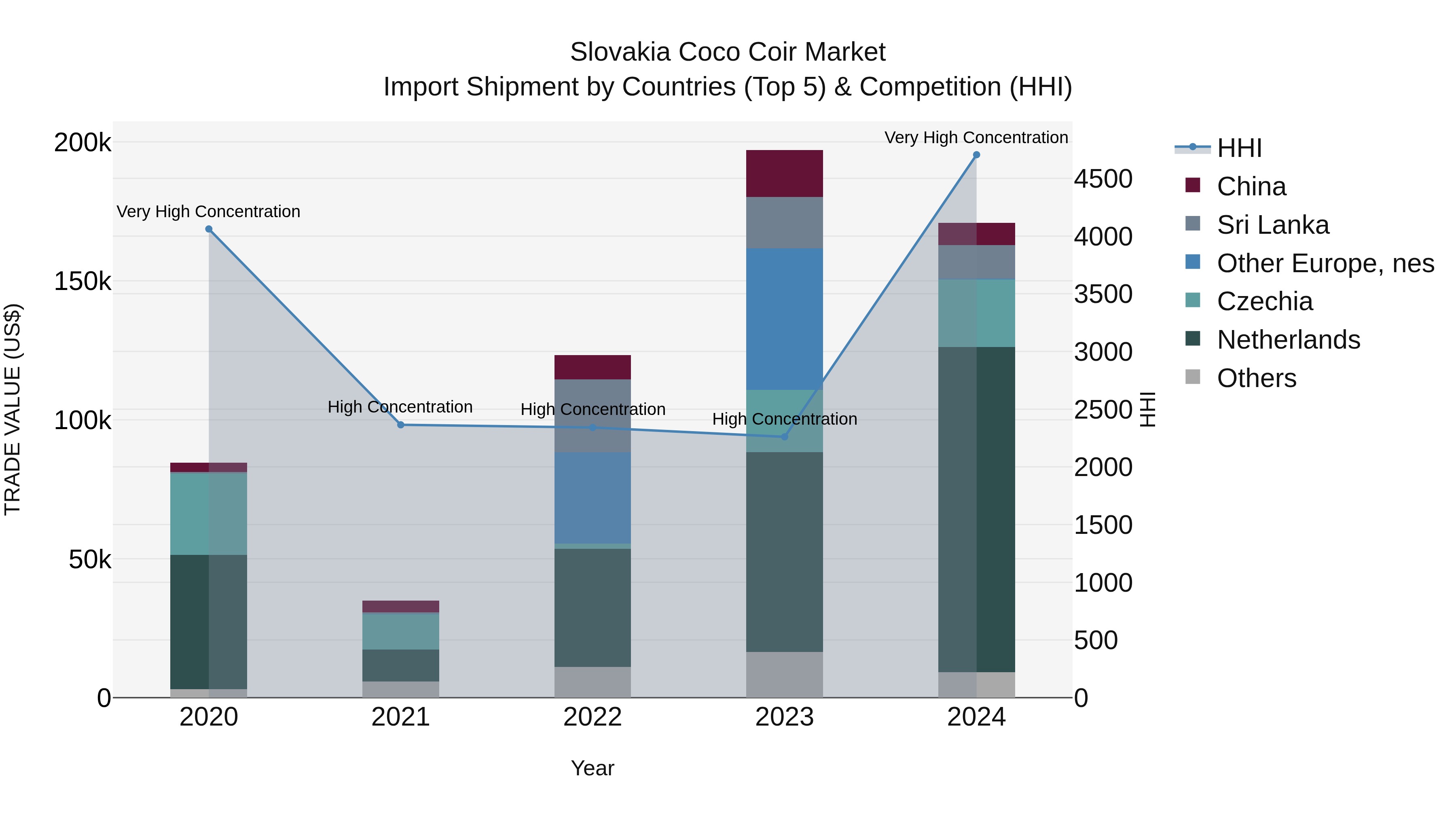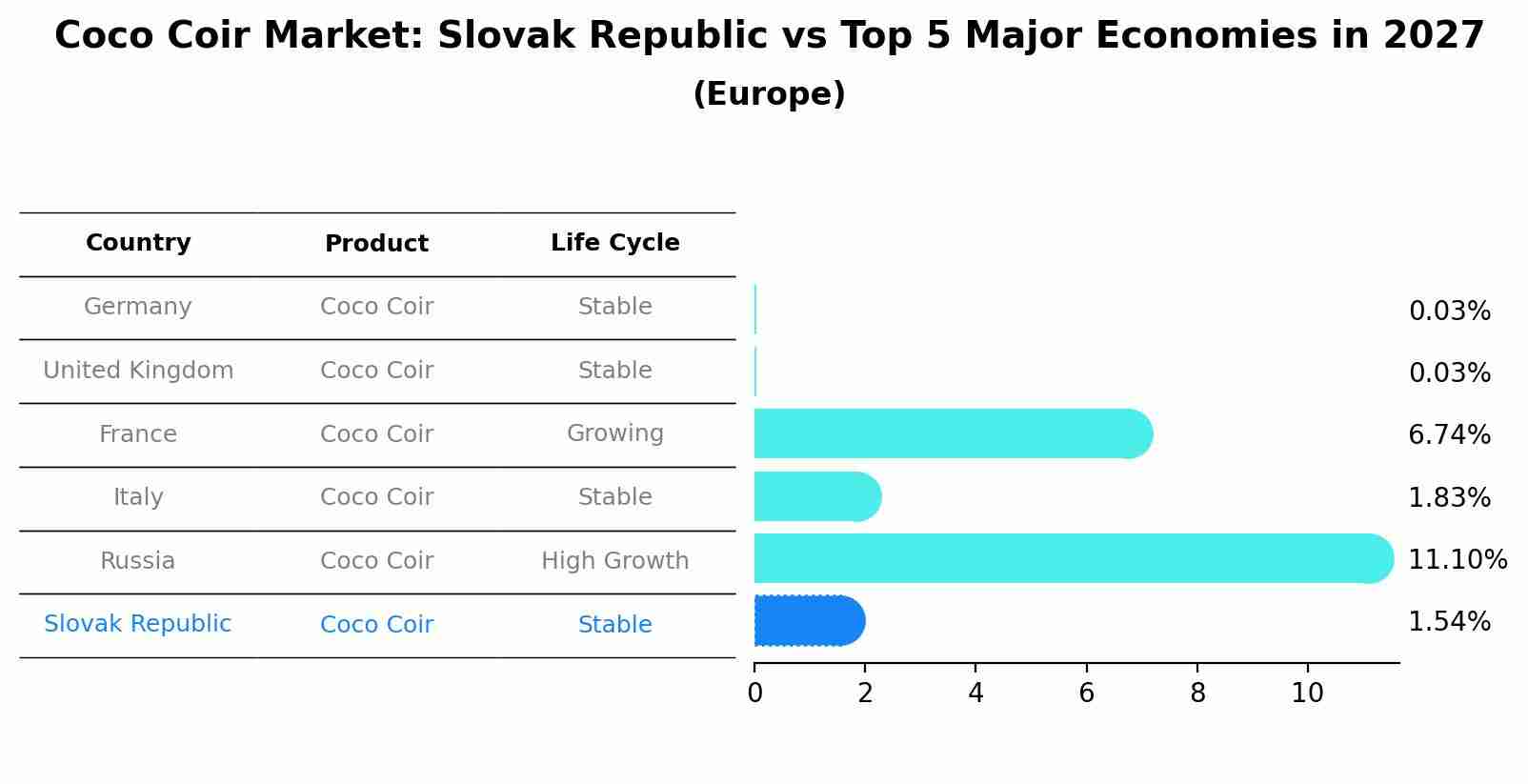Slovakia Coco Coir Market Outlook | Revenue, Value, Forecast, Trends, Companies, Size, Share, Growth, Analysis, Industry & COVID-19 IMPACT
| Product Code: ETC373700 | Publication Date: Aug 2022 | Updated Date: Nov 2025 | Product Type: Market Research Report | |
| Publisher: 6Wresearch | Author: Summon Dutta | No. of Pages: 75 | No. of Figures: 35 | No. of Tables: 20 |
Slovakia Coco Coir Market Top 5 Importing Countries and Market Competition (HHI) Analysis
Slovakia`s coco coir import Market Top 5 Importing Countries and Market Competition (HHI) Analysis saw significant growth from 2020 to 2024, with a strong compound annual growth rate (CAGR) of 19.23%. However, the Market Top 5 Importing Countries and Market Competition (HHI) Analysis experienced a slight decline in growth rate from 2023 to 2024, indicating a potential shift in Market Top 5 Importing Countries and Market Competition (HHI) Analysis dynamics. The top exporting countries to Slovakia in 2024 include the Netherlands, Czechia, Sri Lanka, China, and Germany, with high concentration levels observed. This suggests a competitive Market Top 5 Importing Countries and Market Competition (HHI) Analysis environment with a few key players dominating the import shipments, potentially influencing pricing and supply dynamics in the industry.

Coco Coir Market: Slovak Republic vs Top 5 Major Economies in 2027 (Europe)
In the Europe region, the Coco Coir market in Slovak Republic is projected to expand at a stable growth rate of 1.54% by 2027. The largest economy is Germany, followed by United Kingdom, France, Italy and Russia.

Slovakia Coco Coir Market Synopsis
The Slovakia Coco Coir Market is experiencing steady growth due to the increasing demand for organic and sustainable growing mediums in the agriculture and horticulture sectors. Coco coir, derived from coconut husks, is valued for its water retention properties, aeration, and ability to enhance soil structure. The market is driven by a rising awareness of environmental concerns and the benefits of using coco coir as a peat substitute. Key players in the Slovakia Coco Coir Market include manufacturers, distributors, and retailers who offer a range of coco coir products such as blocks, bricks, and grow bags. The market is also witnessing innovation in product development to cater to various end-user requirements, further boosting its growth potential in the region.
Slovakia Coco Coir Market Trends
Coco coir, also known as coconut fiber, is gaining popularity in the Slovakia market due to its eco-friendly and sustainable nature. The current trends in the Slovakia coco coir market include a growing demand for organic and chemical-free gardening products, which has led to an increased use of coco coir as a soil amendment and growing medium. There is also a rising interest in using coco coir for hydroponic farming and as a component in potting mixes for indoor plants. Manufacturers are focusing on developing innovative coco coir products such as compressed bricks and grow bags to cater to the diverse needs of consumers. Overall, the Slovakia coco coir market is witnessing a shift towards environmentally conscious gardening practices, driving the demand for this versatile and renewable resource.
Slovakia Coco Coir Market Challenges
In the Slovakia Coco Coir Market, some challenges that are commonly faced include limited awareness and knowledge about the benefits of coco coir among potential customers, resulting in slower adoption rates. Another challenge is the availability and consistency of high-quality coco coir products due to fluctuations in supply and demand. Additionally, the transportation and logistics costs associated with importing coco coir from other countries can impact the overall competitiveness of the market. Moreover, the presence of alternative growing mediums and substrates further adds to the competitive landscape. To overcome these challenges, companies operating in the Slovakia Coco Coir Market need to focus on educating consumers, improving product quality and availability, optimizing supply chain processes, and differentiating their offerings to stand out in the market.
Slovakia Coco Coir Market Investment Opportunities
Investment opportunities in the Slovakia Coco Coir Market include setting up coco coir production facilities, establishing distribution networks for coco coir products, and investing in research and development for innovative coco coir applications. With the growing demand for sustainable and eco-friendly products in the horticulture and agriculture sectors, there is a significant opportunity for investors to capitalize on the increasing popularity of coco coir as a substitute for traditional peat moss and other growing mediums. Additionally, investing in marketing and branding strategies to promote the benefits of coco coir to consumers can help capture a larger market share. Overall, the Slovakia Coco Coir Market presents a promising investment landscape for those looking to enter the growing organic and sustainable agriculture industry.
Jordan Agar Market Government Policies
In Slovakia, government policies related to the Coco Coir Market primarily revolve around promoting sustainable agriculture practices and supporting the growth of the organic farming sector. The government has implemented initiatives to provide subsidies and incentives for farmers transitioning to organic farming methods, including the use of coco coir as a sustainable alternative to traditional soil. Additionally, there are regulations in place to ensure the quality and safety of coco coir products, including standards for production, packaging, and labeling. The government also supports research and development efforts in the field of coco coir production to enhance the competitiveness of Slovakian producers in both domestic and international markets. Overall, the government`s policies aim to foster a thriving coco coir industry while promoting environmental sustainability and food security in the country.
Slovakia Coco Coir Market Future Outlook
The future outlook for the Slovakia Coco Coir Market appears promising, with a projected growth trajectory driven by increasing demand for sustainable and eco-friendly growing mediums. As consumers and businesses in Slovakia continue to prioritize environmentally conscious practices, the use of coco coir as a substitute for traditional soil is expected to rise. Additionally, the agriculture and horticulture industries are likely to adopt coco coir due to its water retention properties, aeration benefits, and biodegradability. The market may also benefit from technological advancements in coco coir production processes, leading to improved quality and cost-effectiveness. Overall, the Slovakia Coco Coir Market is anticipated to witness steady growth in the coming years, offering opportunities for suppliers, manufacturers, and distributors to capitalize on the shifting preferences towards sustainable agricultural practices.
Key Highlights of the Report:
- Slovakia Coco Coir Market Outlook
- Market Size of Slovakia Coco Coir Market, 2021
- Forecast of Slovakia Coco Coir Market, 2031
- Historical Data and Forecast of Slovakia Coco Coir Revenues & Volume for the Period 2018 - 2031
- Slovakia Coco Coir Market Trend Evolution
- Slovakia Coco Coir Market Drivers and Challenges
- Slovakia Coco Coir Price Trends
- Slovakia Coco Coir Porter's Five Forces
- Slovakia Coco Coir Industry Life Cycle
- Historical Data and Forecast of Slovakia Coco Coir Market Revenues & Volume By Product for the Period 2018 - 2031
- Historical Data and Forecast of Slovakia Coco Coir Market Revenues & Volume By Coco Coir Grow Bags for the Period 2018 - 2031
- Historical Data and Forecast of Slovakia Coco Coir Market Revenues & Volume By Bales for the Period 2018 - 2031
- Historical Data and Forecast of Slovakia Coco Coir Market Revenues & Volume By Coir Material for the Period 2018 - 2031
- Historical Data and Forecast of Slovakia Coco Coir Market Revenues & Volume By Open Tops for the Period 2018 - 2031
- Historical Data and Forecast of Slovakia Coco Coir Market Revenues & Volume By Blends & Loose Substrate for the Period 2018 - 2031
- Historical Data and Forecast of Slovakia Coco Coir Market Revenues & Volume By Others for the Period 2018 - 2031
- Historical Data and Forecast of Slovakia Coco Coir Market Revenues & Volume By Application for the Period 2018 - 2031
- Historical Data and Forecast of Slovakia Coco Coir Market Revenues & Volume By Rope & Cordage for the Period 2018 - 2031
- Historical Data and Forecast of Slovakia Coco Coir Market Revenues & Volume By Coco Nets & Twines for the Period 2018 - 2031
- Historical Data and Forecast of Slovakia Coco Coir Market Revenues & Volume By Stitched Mats for the Period 2018 - 2031
- Historical Data and Forecast of Slovakia Coco Coir Market Revenues & Volume By Coconut Meals for the Period 2018 - 2031
- Historical Data and Forecast of Slovakia Coco Coir Market Revenues & Volume By Husk for the Period 2018 - 2031
- Historical Data and Forecast of Slovakia Coco Coir Market Revenues & Volume By Others for the Period 2018 - 2031
- Historical Data and Forecast of Slovakia Coco Coir Market Revenues & Volume By Consumer for the Period 2018 - 2031
- Historical Data and Forecast of Slovakia Coco Coir Market Revenues & Volume By Green Houses for the Period 2018 - 2031
- Historical Data and Forecast of Slovakia Coco Coir Market Revenues & Volume By Sellers for the Period 2018 - 2031
- Slovakia Coco Coir Import Export Trade Statistics
- Market Opportunity Assessment By Product
- Market Opportunity Assessment By Application
- Market Opportunity Assessment By Consumer
- Slovakia Coco Coir Top Companies Market Share
- Slovakia Coco Coir Competitive Benchmarking By Technical and Operational Parameters
- Slovakia Coco Coir Company Profiles
- Slovakia Coco Coir Key Strategic Recommendations
Frequently Asked Questions About the Market Study (FAQs):
- Single User License$ 1,995
- Department License$ 2,400
- Site License$ 3,120
- Global License$ 3,795
Search
Thought Leadership and Analyst Meet
Our Clients
Related Reports
- Canada Oil and Gas Market (2026-2032) | Share, Segmentation, Value, Industry, Trends, Forecast, Analysis, Size & Revenue, Growth, Competitive Landscape, Outlook, Companies
- Germany Breakfast Food Market (2026-2032) | Industry, Share, Growth, Size, Companies, Value, Analysis, Revenue, Trends, Forecast & Outlook
- Australia Briquette Market (2025-2031) | Growth, Size, Revenue, Forecast, Analysis, Trends, Value, Share, Industry & Companies
- Vietnam System Integrator Market (2025-2031) | Size, Companies, Analysis, Industry, Value, Forecast, Growth, Trends, Revenue & Share
- ASEAN and Thailand Brain Health Supplements Market (2025-2031) | Strategy, Consumer Insights, Analysis, Investment Trends, Opportunities, Growth, Size, Share, Industry, Revenue, Segments, Value, Segmentation, Supply, Forecast, Restraints, Outlook, Competition, Drivers, Trends, Demand, Pricing Analysis, Competitive, Strategic Insights, Companies, Challenges
- ASEAN Bearings Market (2025-2031) | Strategy, Consumer Insights, Analysis, Investment Trends, Opportunities, Growth, Size, Share, Industry, Revenue, Segments, Value, Segmentation, Supply, Forecast, Restraints, Outlook, Competition, Drivers, Trends, Demand, Pricing Analysis, Competitive, Strategic Insights, Companies, Challenges
- Europe Flooring Market (2025-2031) | Outlook, Share, Industry, Trends, Forecast, Companies, Revenue, Size, Analysis, Growth & Value
- Saudi Arabia Manlift Market (2025-2031) | Outlook, Size, Growth, Trends, Companies, Industry, Revenue, Value, Share, Forecast & Analysis
- Uganda Excavator, Crane, and Wheel Loaders Market (2025-2031) | Strategy, Consumer Insights, Analysis, Investment Trends, Opportunities, Growth, Size, Share, Industry, Revenue, Segments, Value, Segmentation, Supply, Forecast, Restraints, Outlook, Competition, Drivers, Trends, Demand, Pricing Analysis, Competitive, Strategic Insights, Companies, Challenges
- Rwanda Excavator, Crane, and Wheel Loaders Market (2025-2031) | Strategy, Consumer Insights, Analysis, Investment Trends, Opportunities, Growth, Size, Share, Industry, Revenue, Segments, Value, Segmentation, Supply, Forecast, Restraints, Outlook, Competition, Drivers, Trends, Demand, Pricing Analysis, Competitive, Strategic Insights, Companies, Challenges
Industry Events and Analyst Meet
Whitepaper
- Middle East & Africa Commercial Security Market Click here to view more.
- Middle East & Africa Fire Safety Systems & Equipment Market Click here to view more.
- GCC Drone Market Click here to view more.
- Middle East Lighting Fixture Market Click here to view more.
- GCC Physical & Perimeter Security Market Click here to view more.
6WResearch In News
- Doha a strategic location for EV manufacturing hub: IPA Qatar
- Demand for luxury TVs surging in the GCC, says Samsung
- Empowering Growth: The Thriving Journey of Bangladesh’s Cable Industry
- Demand for luxury TVs surging in the GCC, says Samsung
- Video call with a traditional healer? Once unthinkable, it’s now common in South Africa
- Intelligent Buildings To Smooth GCC’s Path To Net Zero


















